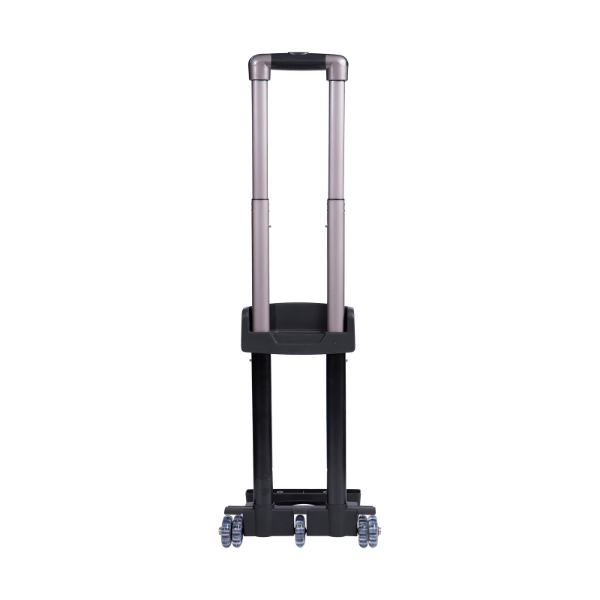When we think of a suitcase, the first thing that comes to mind is its size, color, or brand. Rarely do we pay attention to one of its most critical components—the luggage pull rod. This seemingly simple mechanism is responsible for the ease, durability, and maneuverability of your travel companion. Whether you’re traveling for business, vacation, or study, a reliable pull rod can make or break your journey.
What Is a Luggage Pull Rod?
A luggage pull rod (also called a trolley handle or telescopic handle) is the retractable metal bar that extends from the suitcase to allow the user to pull it along on wheels. It’s usually located at the top rear part of a rolling suitcase and can be locked at different lengths for comfort and ease of use.
What Are the Key Components of a Luggage Pull Rod?
Telescopic Tubes
Most pull rods are composed of two or three metal tubes that can slide into each other, allowing them to extend and retract.
Handle Grip
Located at the top, usually ergonomically designed and made of rubber, plastic, or silicone for a comfortable grip.
Locking Mechanism
Ensures the rod stays at the desired height. High-quality rods use button-activated spring locks or automatic position locks.
Guide Rails and Bushings
Internal components that help the rod move smoothly without jamming.
What Materials Are Commonly Used in Luggage Pull Rods?
| Material | Features | Application |
| Aluminum Alloy | Lightweight, corrosion-resistant, strong | Mid to high-end luggage |
| Stainless Steel | Very durable, heavier, rust-resistant | Heavy-duty or luxury luggage |
| Plastic/ABS | Cost-effective, less durable | Budget or kids' suitcases |
| Carbon Fiber | Ultra-light and extremely strong | Premium, high-performance luggage |
Aluminum alloy is the most popular choice due to its balance of weight and durability.
What Are the Types of Luggage Pull Rods?
Two-Section Rods
Simple design with two telescopic levels. Lightweight and economical.
Three-Section Rods
Offers more adjustable height options, better for taller users or heavier bags.
Single Pole Rods
Less common, usually used in briefcases or children’s luggage.
Double Pole Rods
Most standard suitcases use this for better balance and structural integrity.

What Problems Can Occur with Pull Rods?
Jamming or Stuck Rods: Caused by dirt, dents, or misaligned tubes.
Loose Lock Mechanism: Rod collapses during use, leading to user discomfort.
Bent or Broken Poles: Usually due to rough handling or low-quality materials.
Wobbling or Shaking: Often seen in cheaper products or after extensive use.
How to Choose a Durable Luggage Pull Rod?
Check Material Quality: Aluminum or stainless steel rods are more reliable.
Test the Locking System: It should engage and disengage easily and firmly.
Extend Fully: The rod should feel stable and smooth at full extension.
Grip Comfort: Choose ergonomically designed handles for long travel.
Brand Reputation: Well-known brands often invest in better components.
Why Do Some Pull Rods Feel Unstable?
A wobbly pull rod can result from poor assembly, weak tubing, or lack of internal support. Premium luggage brands often reinforce the internal mount points and use thicker gauge tubes, which significantly improves stability.
Are There Innovative Features in Modern Luggage Pull Rods?
Yes! With travel becoming more tech-oriented, some pull rods now offer:
Built-in USB Charging Ports (integrated in the rod frame)
Smart Height Sensors (adjust to your body automatically)
Carbon Fiber Construction for ultra-lightweight travel
360-Degree Rotation Handles for flexible movement
How to Maintain Your Luggage Pull Rod?
To extend the life of your pull rod, follow these tips:
Keep it Clean: Wipe with a damp cloth regularly to avoid dirt accumulation.
Lubricate Moving Parts: Use silicone spray or light oil sparingly on joints.
Avoid Overweight Loads: Excess weight can cause the rod to bend or break.
Store Properly: Don’t force the rod closed if stuck; inspect for debris first.
Popular Questions About Luggage Pull Rods
Q1: Why does my pull rod jam when I try to extend it?
A: This can be due to internal dust or misalignment. Clean the tube and apply silicone spray.
Q2: Is a 3-section rod better than a 2-section one?
A: Generally yes. It allows more height adjustment and compact storage.
Q3: How long should a pull rod last?
A: With regular use and good care, quality rods can last 5–10 years or longer.
Q4: Can I replace a broken pull rod?
A: Yes. Many manufacturers offer replacement rods, or third-party options are available online.
Q5: Is aluminum pull rod better than steel?
A: Aluminum is lighter and rust-resistant, while steel is heavier but more impact-resistant.
Final Thoughts
Though often overlooked, the luggage pull rod is a critical part of your suitcase’s usability and reliability. Choosing a high-quality rod ensures better comfort, reduced strain, and greater longevity for your travel gear. As suitcases become more intelligent and user-centric, pull rods are also evolving to meet the needs of the modern traveler.




 Español
Español











